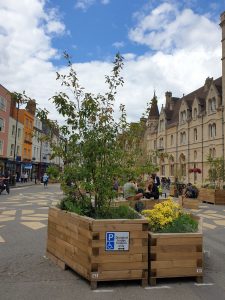Projects
Follow the link to our showcase of six of our projects described by their leads, with illustrations and links.
Here’s a summary of some of our other studies with links to relevant material.
*New project* Walking under the trees. A preliminary study of urban green management and walkability
lead: Dr. Ersilia Verlinghieri
This project will use interviews and street audits to begin understanding how urban trees are managed in the UK, and in particular the extent to which issues of walkability and accessibility are considered in decisions about pavement greenery.

Street trees perform a number of key functions in cities, which are increasingly being recognised in policy and research. For example, they are one of the most effective ways of keeping urban temperatures manageable during heatwaves, which scientists predict will become more frequent in the coming years. They also have screening and aesthetic functions. For example, in many cases they can screen the effects of air pollution and, if properly positioned and managed, can create more pleasant walking conditions. However, in many cities, including London, streets in the poorest neighbourhoods cannot accommodate street trees due to pavements being narrow and cluttered. Similarly, the conflicting demands for street and pavement space, including for walking and cycling, means that trees are often cut down or heavily pruned to reduce their size. Conversely, when left grow unmanaged, trees and their roots can risk making pavements less accessible.
This pilot project will seek to develop a preliminary understanding of how urban trees are managed at local, regional and national level in the UK, and in particular the extent to which issues of walkability and accessibility are considered in decisions about pavement greenery.
The findings will be based on a series of interviews with stakeholders in London (UK) (local and national policy makers and members of NGOs and citizens’ organisations mobilised around issues of walkability and urban greenery) exploring how ideas of access and walkability are intertwined with issues of safety (for pedestrians, drivers, parked vehicles) and health in the management of pavement greenery. The interviews will be complemented by a review of relevant policy document and a street audit in two London boroughs using video/photo and GPS tracking.
Some other current and recent projects
-
-
- A three-year DfT-funded study of Active Travel Fund schemes introduced across England, including scheme impacts and processes. This uses a range of data sources including focus group research with local authority officers, which has uncovered enablers and barriers to implementation including specific challenges faced in rural authorities. Lead: Professor Rachel Aldred.
- A study for the Local Government Association looking at the implementation of emergency Covid-19 streetscape schemes in England. This has led to the LGA making recommendations to member bodies in a published report. Lead: Dr. Tom Cohen.
- A five-year longitudinal study funded by Transport for London of impacts of active travel investment in Outer London. The study has showed that people living near schemes – particularly ambitious measures – walked and cycled more, with the biggest absolute increase being in walking levels. However, many schemes are perceived as cycling schemes. Lead: Professor Rachel Aldred
- A University funded PhD project exploring children’s independent mobility and uncovering the role played by intermediate spaces, such as the corner shop as a trusted local destination enabling a step towards greater independence. Lead: Dr. Holly Weir (who most recently presented this work at Living Streets’ National Walking Summit).
- A project funded by Impacts on Urban Health to identify ways to maximise health and wellbeing for cargo bike delivery riders whilst supporting upscaling of cargo bike operators. Lead: Dr. Ersilia Verlinghieri, building on earlier research with Irena Itova analysing impact of a shift from vans to cargo bikes.
-